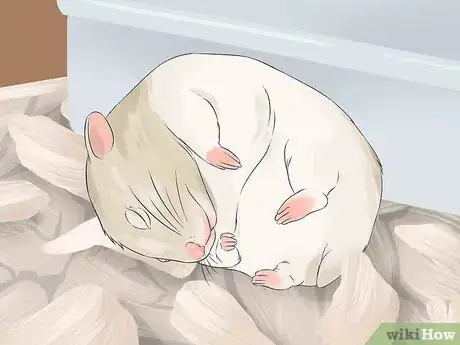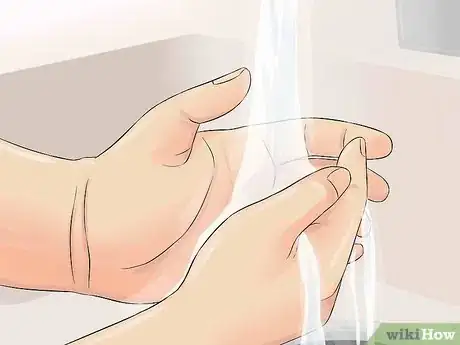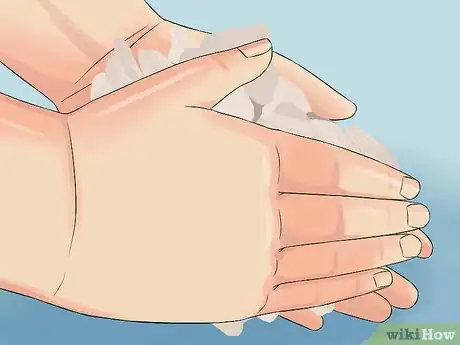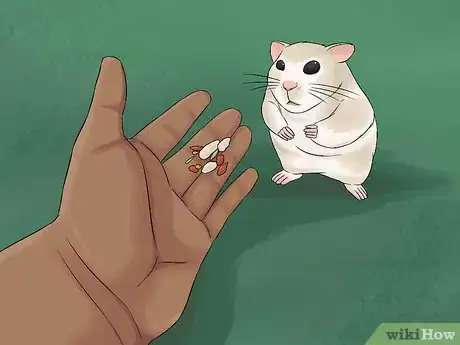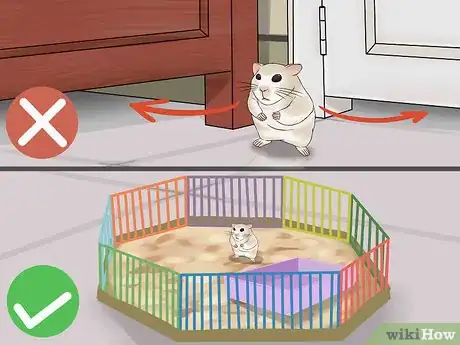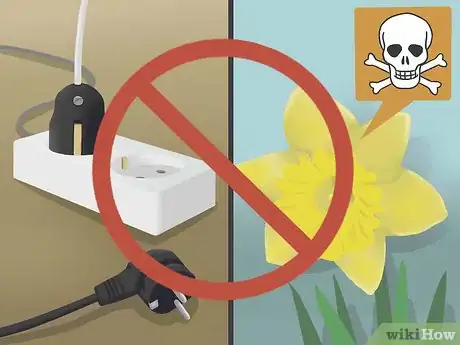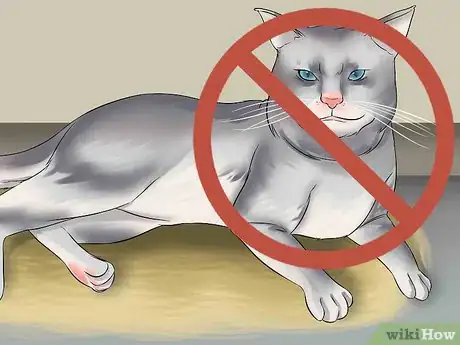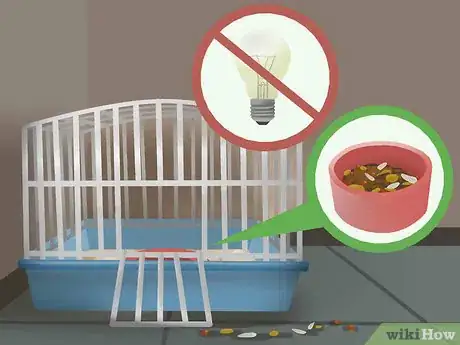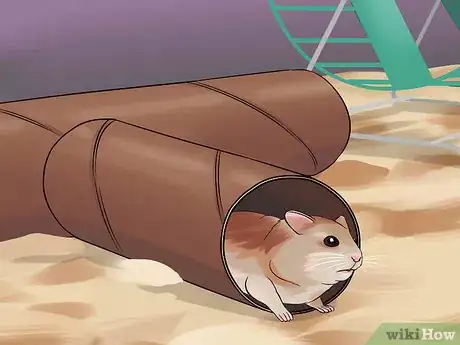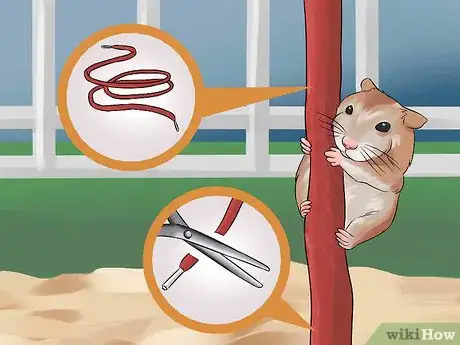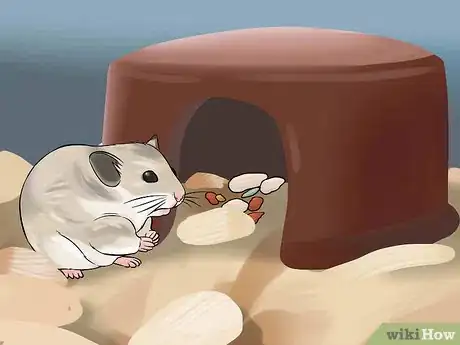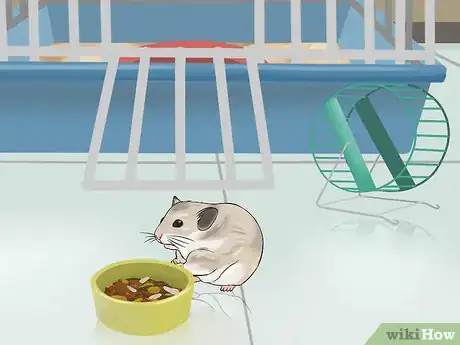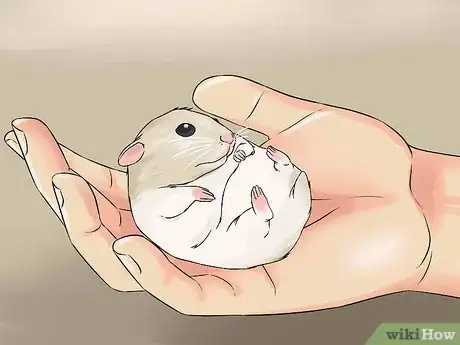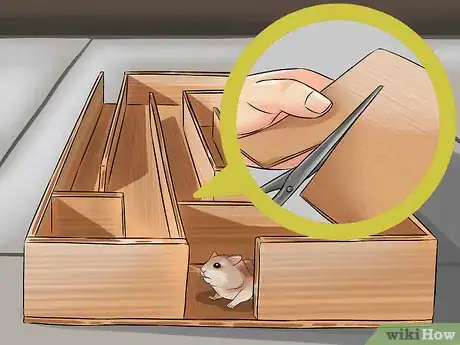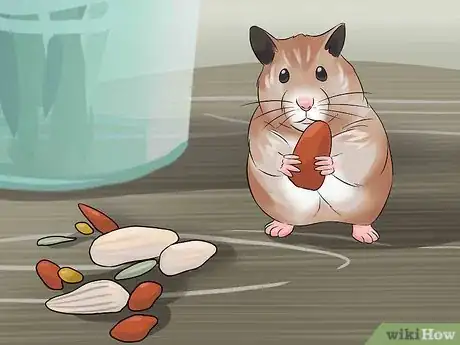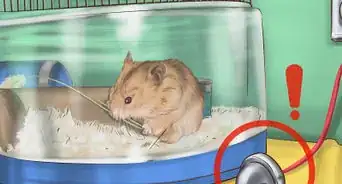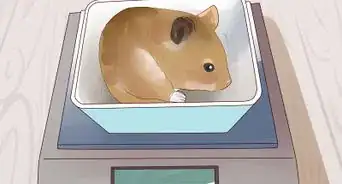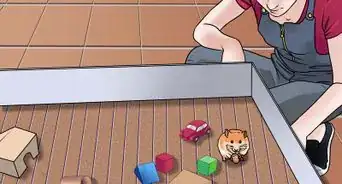This article was co-authored by Pippa Elliott, MRCVS. Dr. Elliott, BVMS, MRCVS is a veterinarian with over 30 years of experience in veterinary surgery and companion animal practice. She graduated from the University of Glasgow in 1987 with a degree in veterinary medicine and surgery. She has worked at the same animal clinic in her hometown for over 20 years.
There are 13 references cited in this article, which can be found at the bottom of the page.
wikiHow marks an article as reader-approved once it receives enough positive feedback. This article has 14 testimonials from our readers, earning it our reader-approved status.
This article has been viewed 219,439 times.
Playing with your hamster provides her with the stimulation she needs to stay healthy. And whether you are letting your little furry friends crawl all over you or watching her conquer a maze, playing with your hamster is great fun. However, you must handle your hamster properly to ensure her safety while playing inside or outside of her cage.
Things You Should Know
- Hand-tame your hamster before you start picking them up or trying to play with them.
- Watching your hamster run and interact with new toys in their environment can be a blast.
- Letting your hamster play and explore outside of their cage is a great way to stimulate them while having fun.
- Make sure that your hamster won’t escape or interact with anything dangerous when you let them out.
Steps
Handling Your Hamster Safely
-
1Let sleeping hamsters lie. Hamsters sleep most of the day and are most active in the evening and night. If you wake your hamster, they might be grumpy and resistant to handling. Always let your hamster wake up on their own before playing with him/her.[1]
-
2Wash your hands first. Hamsters have a very keen sense of smell. It is important that you wash all food scents off your hands, or your hamster may bite you.[2]Advertisement
-
3Rub your hands in clean hamster bedding. The smell of bedding will make your hamster feel safer in your hands.[3]
-
4Hand-tame your hamster. Before you can play with your hamster outside their cage, you need to get them used to being handled by you. Start by feeding your hamster treats from your hand. When your hamster approaches you without fear, try letting them play in your hand. When they are comfortable there, pick them up. Gradually increase the amount of time you hold your hamster.[4]
- Always let your hamster sniff at your closed fist before attempting to pick them up. Do not surprise them.[5]
- Always handle your hamster over a table or while sitting on the ground. Otherwise, your hamster might suffer a serious injury if they squirm out of your grasp. A fall of only one foot can seriously injure a hamster.[6]
- If your hamster tries to squirm away or bites you, put it back in its cage. It is tired of being held.
-
5Make sure your hamster cannot escape when playing outside their cage. Play with your hamster in an enclosed area. Be aware that hamsters can escape through very small spaces, such as under doors, so you will need to keep your pet under supervision when playing outside its cage.[7]
- Don’t play in an area with a small space that your hamster can squeeze into to hide, such as underneath couches or drawers.
- Bathrooms are convenient enclosed space to play in, but be sure to shut the toilet lid.
- Consider purchasing a hamster playpen to make sure your pet can’t escape. It should be larger than the hamster’s cage. Also consider covering the pen with a mesh screen so your pet can’t escape.
- Purchasing a child’s wading pool is an easy way to provide an enclosed, inexpensive play space.
-
6Remove any hazards when playing outside the cage. If it’s there, your hamster will probably chew on it. Be sure to remove all electrical cords from the area where your hamster is playing.[8] Also remove any toxic plants, such as azalea, daffodil, oleander, speedwell, buttercups, bindweed, bluebells, ragwort, elder, hemlock, and privet. For a complete list of toxic plants, see here.
-
7Be careful when playing with your hamster on a table or counter. Hamsters have almost no instinctual fear of falling, and a tumble off a high table or counter can seriously injure your pet. Don’t leave your hamster alone in high places, and always be on hand to keep them from falling.[9]
-
8Remove your other pets from the room when playing with your hamster out of the cage. Imagine sharing a room with a giant monster that wants to eat you. Not fun. Even if your hamster is safe, they will find the presence of your dog or cat stressful.[10]
-
9Know how to recapture your hamster if they escape. If your hamster gets loose, all is not lost. Having a plan in advance can ward off panic and make it much more likely you will find your pet.[11]
- Search near the hamster’s cage first.
- Look in small places: behind and underneath furniture, in between cushions on sofas and chairs, on bookshelves, in drawers, and inside shoes, tissues boxes, and shoe boxes.
- If your search fails, leave the cage open and place your hamster’s favorite food near and inside it. Turn out the lights and wait for your hamster to come.
- If that fails, set out some food before you go to sleep and surround it with flour so that your hamster’s tracks lead you back to its hiding place.
Having Fun with Your Hamster in the Cage
-
1Watch your hamster run. Wild hamsters run miles each day to find food. Your pet doesn’t have to work that hard, but they still have the instinct to run. Put a hamster wheel in your pet’s cage and watch them go.[12]
- The wheel should be large enough that your hamster’s back does not bend.[13]
- Solid wheels are preferable, as your hamsters toes or legs may get caught between the bars of a wire wheel.[14]
- Check the wheel periodically to make sure it is rotating freely. Remove any obstructions as needed and grease with olive oil or vegetable oil.
-
2Add some nature. Wooden branches give your hamster something to chew and climb on in their cage, but make sure they are thoroughly cleaned first. Wash each branch with soapy water, let it dry, and then bake it for 45 minutes at 200°F to kill any bugs or eggs. And be sure to use wood that is not toxic to hamsters, such as willow, pear or apple, cottonwood, pecan, or mulberry. For a full list of safe and unsafe woods, see here.
-
3Create a cardboard tube maze. Hamsters love to crawl through leftover toilet paper and paper towel tubes. Try taping several together to make a tunnel maze for your pet.[15]
-
4Make a swing with a little string and a used roll of duct tape or packaging tape. Simply run the string through the roll and tie it to the top of your hamster’s habitat so that it hangs just off the floor.[16]
-
5Tie shoelaces to the top of your hamster’s cage. Tie several laces from side to side or leave a few hanging down. Your hamster will love to climb and pull on them. But be sure to remove the plastic tips covering the ends, so that your pet does not eat them and get sick.
-
6Hide food in your hamster’s cage and watch them find it. Hamster’s love to forage for food. Hide food all around your hamster’s cage – in tubes, on platforms, in corners – and watch them find it.[17]
Playing Outside the Cage
-
1Let your hamster out of their cage to play every day. To maximize your hamster’s health and happiness, you need to give them time outside their cage. And it’s fun! Just be sure your that hamster is hand-tamed and that you play with them in a safe, enclosed area.[18]
-
2Cuddle your hamster and let them crawl on you. Some hamsters enjoy being cuddled, so long as you don’t squeeze too hard, and they’ll also have fun exploring you. This is a great way to bond with your hamster and teach them to trust you. However, some hamsters don't enjoy human interaction.
- Be sure you are seated on the ground so that your hamster doesn’t hurt themself if they fall.
- Make sure you are in an enclosed area so your hamster can’t escape.[19]
- Limit your time handling your hamster to 10-15 minutes, and for the first few times only 3-4 minutes. If you handle your hamster for too long, they will try to escape or bite you.[20]
-
3Make a maze. You can make your maze walls out of anything: glued together Popsicle sticks, cardboard, blocks, books, etc. Place some treats in the maze and watch your hamster explore.[21] To make sure your hamster doesn’t escape, consider placing the maze inside a large cardboard box.
-
4Put your hamster in a playpen with toys. Any secure area with no means of escape can serve as a playpen for your hamster. You can purchase a variety of toys, but your pet will also enjoy exploring household objects such as:
- Paper towel or toilet paper tubes
- Tissue or shoe boxes
- Paper bags
- Shoes
- Ramps (a propped up piece of wood or cardboard)
- Cereal boxes
-
5Watch your hamster gather food. A hamster can carry up to half of their body weight in their cheek pouches! Scatter grains or crumbs on the table and watch your hamster collect them.[22] But be careful what you feed your hamster. Foods to avoid include:[23]
- Junk food: pizza, chocolate, potato chips, pickles, salted peanuts or other high salt foods
- Citrus fruits, dried fruits, fruit pips, or apple seeds
- Iceberg lettuce, parsley, or rhubarb
- Avocado, eggplant, onions, peppers, mushrooms, or garlic
- Potatoes, kidney beans or red beans
- Red meat
Expert Q&A
-
QuestionWhen I offer my hamster his favorite food on my hand, he bites me. What should I do?
 Pippa Elliott, MRCVSDr. Elliott, BVMS, MRCVS is a veterinarian with over 30 years of experience in veterinary surgery and companion animal practice. She graduated from the University of Glasgow in 1987 with a degree in veterinary medicine and surgery. She has worked at the same animal clinic in her hometown for over 20 years.
Pippa Elliott, MRCVSDr. Elliott, BVMS, MRCVS is a veterinarian with over 30 years of experience in veterinary surgery and companion animal practice. She graduated from the University of Glasgow in 1987 with a degree in veterinary medicine and surgery. She has worked at the same animal clinic in her hometown for over 20 years.
Veterinarian Hamsters have poor eyesight so it could be that your hamster smells the food but doesn't see your hand and accidentally chomps down on a finger. To make friends, try offering the treat on a teaspoon. Be sure to have clean hands (not smelling of food), and, once he's happy with the hand in the cage, try touching him gently.
Hamsters have poor eyesight so it could be that your hamster smells the food but doesn't see your hand and accidentally chomps down on a finger. To make friends, try offering the treat on a teaspoon. Be sure to have clean hands (not smelling of food), and, once he's happy with the hand in the cage, try touching him gently. -
QuestionIs my hamster afraid of me when it nibbles me?
 Pippa Elliott, MRCVSDr. Elliott, BVMS, MRCVS is a veterinarian with over 30 years of experience in veterinary surgery and companion animal practice. She graduated from the University of Glasgow in 1987 with a degree in veterinary medicine and surgery. She has worked at the same animal clinic in her hometown for over 20 years.
Pippa Elliott, MRCVSDr. Elliott, BVMS, MRCVS is a veterinarian with over 30 years of experience in veterinary surgery and companion animal practice. She graduated from the University of Glasgow in 1987 with a degree in veterinary medicine and surgery. She has worked at the same animal clinic in her hometown for over 20 years.
Veterinarian Nibbling is the hamster's way of investigating whether something is food or not. It is a type of exploratory behavior rather than fear-based or aggressive. If your hamster is a nibbler, always wash your hands before handling him or he may mistake the smell as meaning your hand is food and bite harder!
Nibbling is the hamster's way of investigating whether something is food or not. It is a type of exploratory behavior rather than fear-based or aggressive. If your hamster is a nibbler, always wash your hands before handling him or he may mistake the smell as meaning your hand is food and bite harder! -
QuestionIs it okay to carry my hamster around in the palm of my hand?
 Pippa Elliott, MRCVSDr. Elliott, BVMS, MRCVS is a veterinarian with over 30 years of experience in veterinary surgery and companion animal practice. She graduated from the University of Glasgow in 1987 with a degree in veterinary medicine and surgery. She has worked at the same animal clinic in her hometown for over 20 years.
Pippa Elliott, MRCVSDr. Elliott, BVMS, MRCVS is a veterinarian with over 30 years of experience in veterinary surgery and companion animal practice. She graduated from the University of Glasgow in 1987 with a degree in veterinary medicine and surgery. She has worked at the same animal clinic in her hometown for over 20 years.
Veterinarian There are two things to consider here: how frightened the hamster is and how safe he is. If he is relaxed in your palm and is happy to groom himself whilst resting there, then with care you could carry him around. However, there is a risk that if he took fright or you tripped, he could fall out of your hand, which could cause him serious injury.
There are two things to consider here: how frightened the hamster is and how safe he is. If he is relaxed in your palm and is happy to groom himself whilst resting there, then with care you could carry him around. However, there is a risk that if he took fright or you tripped, he could fall out of your hand, which could cause him serious injury.
References
- ↑ http://www.petplace.com/article/small-mammals/general/enjoying-your-small-mammal/having-fun-with-your-hamster
- ↑ http://www.petplace.com/article/small-mammals/general/enjoying-your-small-mammal/having-fun-with-your-hamster
- ↑ https://www.youtube.com/watch?v=vVFp8LgMQrE
- ↑ http://animals.mom.me/hamsters-like-affection-1043.html
- ↑ http://dwarfhamsterblog.com/dwarf-hamster-care/
- ↑ http://animals.mom.me/games-hamsters-love-3158.html
- ↑ http://www.smallanimalchannel.com/hamsters/hamster-behavior/hamster-out-of-cage.aspx
- ↑ http://www.smallanimalchannel.com/hamsters/hamster-behavior/hamster-out-of-cage.aspx
- ↑ http://www.petplace.com/article/small-mammals/general/enjoying-your-small-mammal/having-fun-with-your-hamster
- ↑ http://www.smallanimalchannel.com/hamsters/hamster-behavior/hamster-out-of-cage.aspx
- ↑ http://www.smallanimalchannel.com/hamsters/hamster-behavior/hamster-out-of-cage.aspx
- ↑ http://www.petplace.com/article/small-mammals/general/enjoying-your-small-mammal/having-fun-with-your-hamster
- ↑ http://www.willows.uk.net/en-GB/general-practice-service/looking-after-your-pet/looking-after-your-hamster
- ↑ http://animals.mom.me/games-hamsters-love-3158.html
- ↑ http://www.petplace.com/article/small-mammals/general/enjoying-your-small-mammal/having-fun-with-your-hamster
- ↑ http://animals.mom.me/build-hamster-toys-out-household-items-4565.html
- ↑ http://dwarfhamsterblog.com
- ↑ https://www.aspca.org/pet-care/small-pet-care/hamster-care
- ↑ http://www.smallanimalchannel.com/hamsters/hamster-behavior/hamster-out-of-cage.aspx
- ↑ http://animals.mom.me/games-hamsters-love-3158.html
- ↑ http://animals.mom.me/build-hamster-toys-out-household-items-4565.html
- ↑ http://www.petplace.com/article/small-mammals/general/enjoying-your-small-mammal/having-fun-with-your-hamster
- ↑ https://mysmelly.com/content/small_animals/dangerous-foods-for-hamsters.htm
About This Article
Before playing with your hamster, rub your hands in clean hamster bedding so your pet feels safe with you. Then, remove your hamster from its cage and place it in a safe, enclosed area. Then, cuddle with your hamster, let it crawl on you, or place it in a hamster ball so it can explore. Make sure you limit your hamster’s time outside of its cage to 10-15 minutes, so it doesn’t get tired or try to escape. If you can’t take your hamster out of its cage, no worries! Read on for suggestions from our Veterinary reviewer about how to have fun with a hamster while it’s still in its cage!
